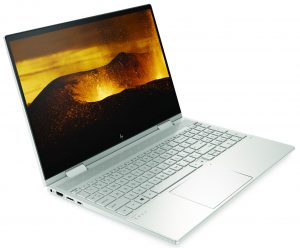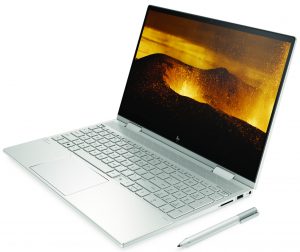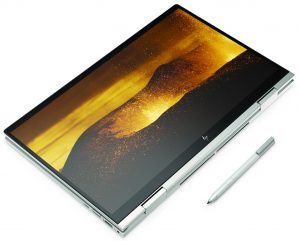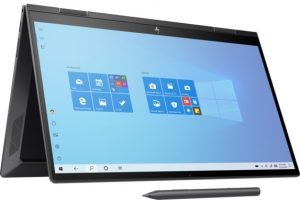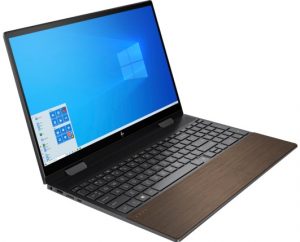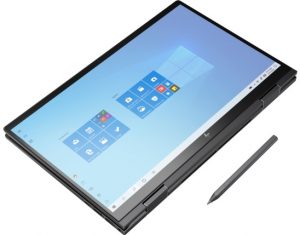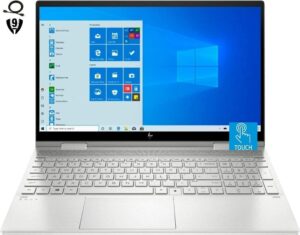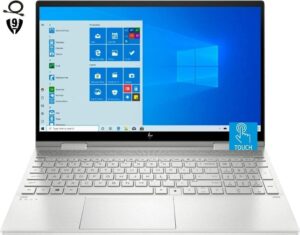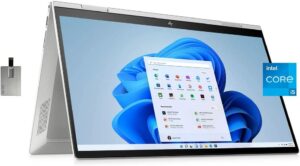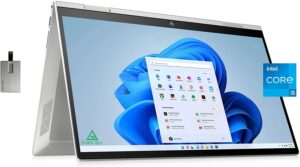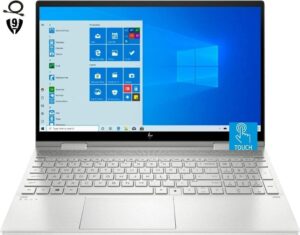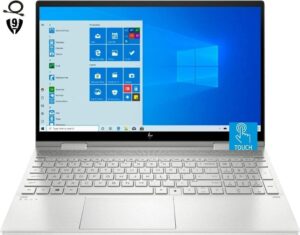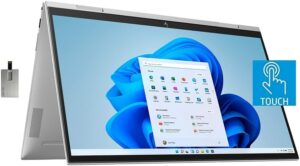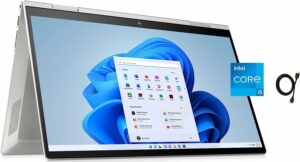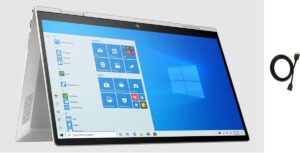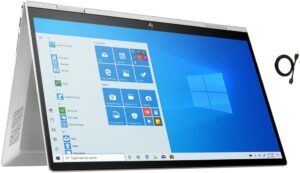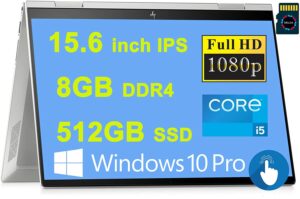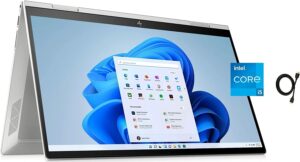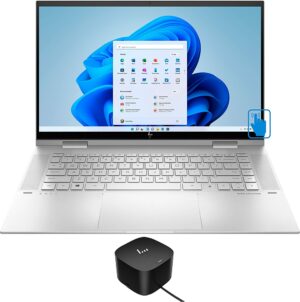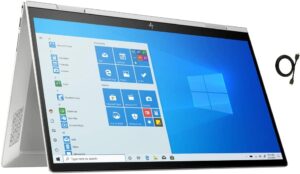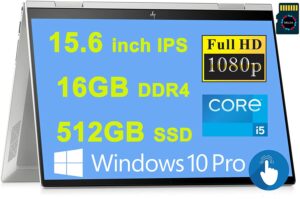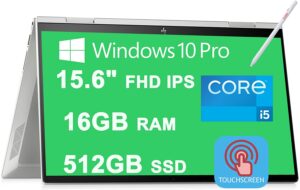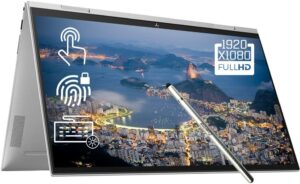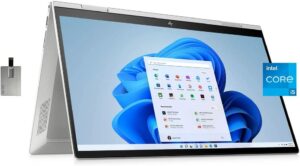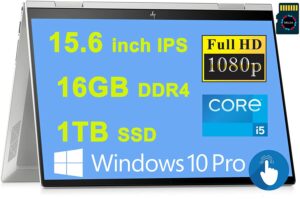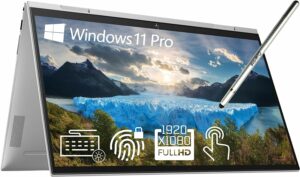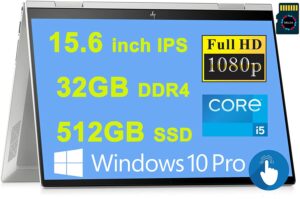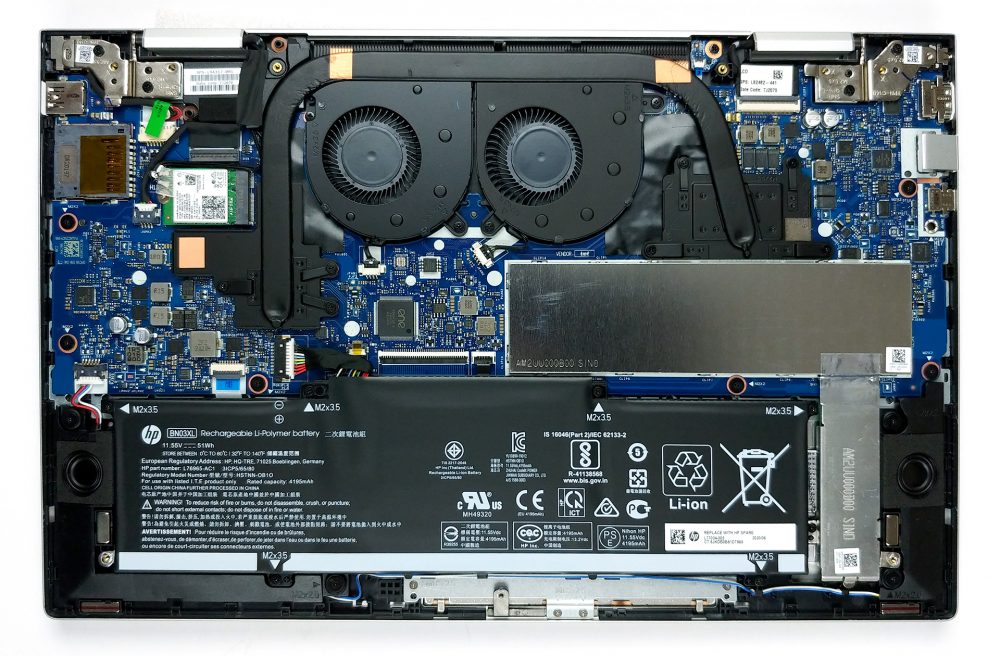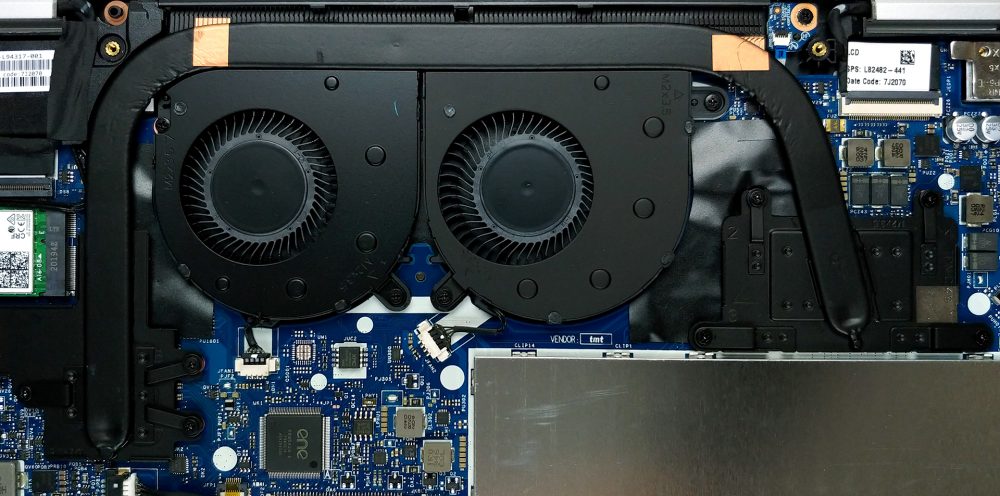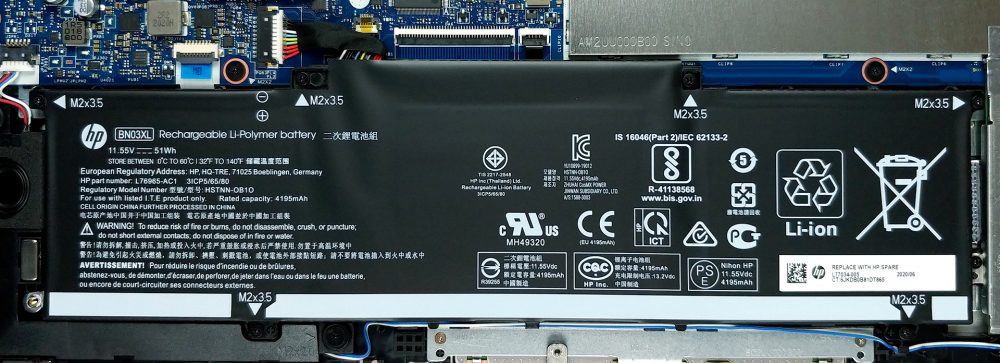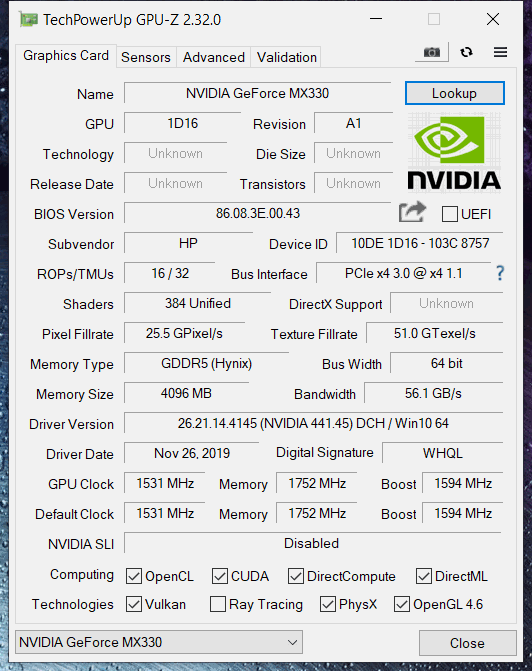HP Envy x360 15 (15-ed0000) review – gives you almost everything you need for graphics design
 Usually, the best screen size for 2-in-1 laptops for art people is 15-inches (or simply said – the bigger – the better). At first glance, the Envy x360 15 (15-ed0000) looks like the perfect notebook for that purpose, with its generally powerful hardware, that maxes out with the Core i7-10510U (Core i7-1065G7) and the 25W version of the GeForce MX330 (4GB GDDR5).
Usually, the best screen size for 2-in-1 laptops for art people is 15-inches (or simply said – the bigger – the better). At first glance, the Envy x360 15 (15-ed0000) looks like the perfect notebook for that purpose, with its generally powerful hardware, that maxes out with the Core i7-10510U (Core i7-1065G7) and the 25W version of the GeForce MX330 (4GB GDDR5).
Of course, we’ve seen a lot of powerful 2-in-1s that just can cut it because of their display. And ultimately, this is the most important feature. Because of that, HP is offering this notebook with a choice of two 1080p IPS panels and one particularly interesting display. Sadly, we weren’t able to snatch a unit equipped with it, but nevertheless, we are talking about a 4K AMOLED display with suggested full DCI-P3 color gamut coverage.
However, we feel that the dubbed 400-nits 1080p IPS model is going to be a pretty good “budget” alternative, so you’re going to learn more about it in this review.
You can check the prices and configurations in our Specs System: https://laptopmedia.com/series/hp-envy-x360-15-15-ed0000/
Contents
Specs Sheet
- HDD/SSD
- up to 2000GB SSD
- M.2 Slot
- 1x 2280 PCIe NVMe 3.0 x4 See photo
- RAM
- up to 64GB
- OS
- Windows 11 Pro, Windows 11 Home, Windows 10 Home, Windows 10 Pro
- Battery
- 51Wh, 3-cell
- Body material
- Aluminum
- Dimensions
- 357.8 x 230.1 x 18.7 mm (14.09" x 9.06" x 0.74")
- Weight
- 1.80 kg (4 lbs)
- Ports and connectivity
- 1x USB Type-A
- 1x USB Type-A
- Sleep and Charge
- 1x USB Type-C
- Power Delivery (PD), DisplayPort, Sleep and Charge
- Card reader
- Multi Format SD
- Wi-Fi
- 802.11ax
- Bluetooth
- 5.0
- Audio jack
- 3.5 mm combo
- Features
- Fingerprint reader
- optional
- Web camera
- HD
- Backlit keyboard
- optional
- Microphone
- Integrated Dual Array Microphone
- Speakers
- 3 Speakers with Bang & Olufsen
- Optical drive
- Security Lock slot
All HP ENVY x360 15 (15-ed0000, ed1000) configurations
What’s in the box?
Inside the package, there is a 65W power adapter with a barrel-style plug, some paper manuals, and an optional Pen.
Design and construction
For a 15-incher with an all-aluminum body, we think that the notebook is pretty light. Its actual weight is 1.80 kg and its profile is about 18.9mm. This makes the laptop feel premium, and be reasonably sturdy. Moreover, its matte grey finish is something that fingerprints are unlikely to be able to stick to.
Sure, the lid doesn’t open with a single hand, but the hinges are tight enough in an opened position, so this won’t result in a flappy display. In addition to the metal cover on the back, the display is protected by glass on the front, which furthermore reduces the possibility of flex.
Speaking of flex, the keyboard deck is barely flexing, no matter where you push. Also, this is one of the best keyboards we’ve used, when it comes to the typing experience. It has a pretty long travel and a very satisfying click. Also, the keycaps are decent in size, and the only downside of the entire unit is the awkward position of the Power button – HP crammed it into the delete and backspace keys. On the bright side, this notebook has a fingerprint reader, which is pretty big in size, and the touchpad is smooth with its glass surface and accurate tracking.
Additionally, HP is using Bang & Olufsen branded speakers, placed right above the keyboard. This means that the bottom panel is only home to the ventilation grill, and expectedly, the hot air is blown through the back.
Ports
On the left side, you’ll find an audio jack, as well as an HDMI 2.0 connector, a USB Type-A 3.2 (Gen. 1) port with Jaw drop mechanism, and a USB Type-C 3.2 (Gen. 2) port. And on the right – there is the charging plug, another USB Type-A 3.2 (Gen. 1) port, and an SD card reader.
Disassembly, upgrade options, and maintenance
This is one of the cheekiest moves by HP so far. Not only there is only one visible screw at first glance, but it is also of a Torx type. To further make you stay away from this notebooks internals, the manufacturer has hidden all 8 of the rest Phillips-head screws beneath the rubber feet – two in the front and six in the back. After you located and remove them, you only need to pop the panel away with a plastic tool.
Interestingly, this notebook uses a pretty similar cooling solution to that of the 13-inch model. However, instead of the single fan, there are two inside of this one.
Thankfully, you can upgrade the memory via two RAM SODIMM slots, located beneath a metal cover. And as for the storage, there is one M.2 slot, supporting PCIe x4 drives.
Last but not least, this notebook is powered by a 51Wh battery pack.
Display quality
HP Envy x360 15 (15-ed0000) has a Full HD IPS panel with a model number Innolux N156HCG-GT1 (CMN1517). Its diagonal is 15.6″ (39.62 cm), and the resolution 1920 х 1080 pixels. The screen ratio is 16:9, and we are looking at a pixel density of – 142 ppi, and a pitch of 0.18 х 0.18 mm. The screen turns into Retina when viewed at distance equal to or greater than 60cm (24″) (from this distance one’s eye stops differentiating the separate pixels, and it is normal for looking at a laptop).

Viewing angles are comfortable. We offer images at 45° to evaluate image quality.

We measured a maximum brightness of 411 nits in the middle of the screen and 380 nits as an average for the whole area, with a maximum deviation of 14%. The Correlated Color Temperature on a white screen is 5950K – slightly warmer than the optimal for the sRGB standard of 6500K, which is not bad at all
In the illustration below you can see how the display performs from a uniformity perspective. In other words, the leakage of light from the light source.
Values of dE2000 over 4.0 should not occur, and this parameter is one of the first you should check if you intend to use the laptop for color-sensitive work. The contrast ratio is good – 1620:1.
To make sure we are on the same page, we would like to give you a little introduction to the sRGB color gamut and the Adobe RGB. To start, there’s the CIE 1976 Uniform Chromaticity Diagram that represents the visible specter of colors by the human eye, giving you a better perception of the color gamut coverage and the color accuracy.
Inside the black triangle, you will see the standard color gamut (sRGB) that is being used by millions of people in HDTV and on the web. As for the Adobe RGB, this is used in professional cameras, monitors, etc for printing. Basically, colors inside the black triangle are used by everyone and this is the essential part of the color quality and color accuracy of a mainstream notebook.
Still, we’ve included other color spaces like the famous DCI-P3 standard used by movie studios, as well as the digital UHD Rec.2020 standard. Rec.2020, however, is still a thing of the future and it’s difficult for today’s displays to cover that well. We’ve also included the so-called Michael Pointer gamut, or Pointer’s gamut, which represents the colors that naturally occur around us every day.
The yellow dotted line shows HP Envy x360 15 (15-ed0000)’s color gamut coverage.
Its display covers 97% of the sRGB/ITU-R BT.709 (web/HDTV standard) in CIE1976.

Our “Design and Gaming” profile delivers optimal color temperature (6500K) at 140 cd/m2 luminance and sRGB gamma mode.
We tested the accuracy of the display with 24 commonly used colors like light and dark human skin, blue sky, green grass, orange, etc. You can check out the results at factory condition and also, with the “Design and Gaming” profile.
Below you can compare the scores of HP Envy x360 15 (15-ed0000) with the default settings (left), and with the “Gaming and Web design” profile (right).


The next figure shows how well the display is able to reproduce really dark parts of an image, which is essential when watching movies or playing games in low ambient light.
The left side of the image represents the display with stock settings, while the right one is with the “Gaming and Web Design” profile activated. On the horizontal axis, you will find the grayscale, and on the vertical axis – the luminance of the display. On the two graphs below you can easily check for yourself how your display handles the darkest nuances but keep in mind that this also depends on the settings of your current display, the calibration, the viewing angle, and the surrounding light conditions.

Response time (Gaming capabilities)
We test the reaction time of the pixels with the usual “black-to-white” and “white-to-black” method from 10% to 90% and vice versa.
We recorded Fall Time + Rise Time = 28 ms.

PWM (Screen flickering)
Pulse-width modulation (PWM) is an easy way to control monitor brightness. When you lower the brightness, the light intensity of the backlight is not lowered, but instead turned off and on by the electronics with a frequency indistinguishable to the human eye. In these light impulses, the light/no-light time ratio varies, while brightness remains unchanged, which is harmful to your eyes. You can read more about that in our dedicated article on PWM.
HP Envy x360 15 (15-ed0000)’s backlight doesn’t flicker at any brightness level. This makes the display safe (in this aspect) for long periods of use.

Blue light emissions
Installing our Health-Guard profile not only eliminates PWM but also reduces the harmful Blue Light emissions while keeping the colors of the screen perceptually accurate. If you’re not familiar with the Blue light, the TL;DR version is – emissions that negatively affect your eyes, skin, and your whole body. You can find more information about that in our dedicated article on Blue Light.
Conclusion
HP Envy x360 15 (15-ed0000)’s touchscreen display has an IPS panel with a Full HD resolution, comfortable viewing angles, good contrast ratio, and wide color coverage (97% of sRGB). Additionally, its backlight doesn’t flicker and it has a very accurate color representation when our Gaming and Web design profile is applied. This would make it great for design work and pretty much everyone working with color-sensitive content. However, the imperfect uniformity of our unit means it is inappropriate for the aforementioned situations.
Buy our profiles
Since our profiles are tailored for each individual display model, this article and its respective profile package are meant for HP Envy x360 15 (15-ed0000) configurations with 15.6″ FHD IPS Innolux N156HCG-GT1 (CMN1517).
*Should you have problems with downloading the purchased file, try using a different browser to open the link you’ll receive via e-mail. If the download target is a .php file instead of an archive, change the file extension to .zip or contact us at [email protected].
Read more about the profiles HERE.
In addition to receiving efficient and health-friendly profiles, by buying LaptopMedia's products you also support the development of our labs, where we test devices in order to produce the most objective reviews possible.

Office Work
Office Work should be used mostly by users who spend most of the time looking at pieces of text, tables or just surfing. This profile aims to deliver better distinctness and clarity by keeping a flat gamma curve (2.20), native color temperature and perceptually accurate colors.

Design and Gaming
This profile is aimed at designers who work with colors professionally, and for games and movies as well. Design and Gaming takes display panels to their limits, making them as accurate as possible in the sRGB IEC61966-2-1 standard for Web and HDTV, at white point D65.

Health-Guard
Health-Guard eliminates the harmful Pulse-Width Modulation (PWM) and reduces the negative Blue Light which affects our eyes and body. Since it’s custom tailored for every panel, it manages to keep the colors perceptually accurate. Health-Guard simulates paper so the pressure on the eyes is greatly reduced.
Get all 3 profiles with 33% discount
Sound
HP Envy x360 15 (15-ed0000)’s Bang & Olufsen speakers produce a relatively loud and clear sound with good quality. Also, low, mid, and high tones are clear of deviations.

Drivers
All of the drivers and utilities for this notebook can be downloaded from here: https://support.hp.com/us-en/drivers/selfservice/hp-envy-15-ed0000-x360-convertible-laptop-pc-series/32552495/model/32552497
Battery
Now, we conduct the battery tests with Windows Better performance setting turned on, screen brightness adjusted to 120 nits, and all other programs turned off except for the one we are testing the notebook with. This laptop’s 51Wh battery delivers pretty formidable results. We were able to go through 8 hours and 20 minutes of Web browsing and 8 hours and 56 minutes of video playback.
In order to simulate real-life conditions, we used our own script for automatic web browsing through over 70 websites.
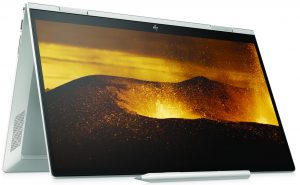
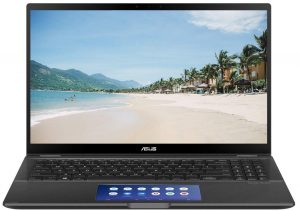
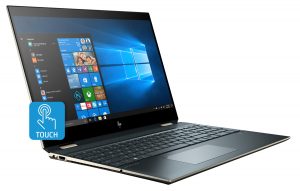
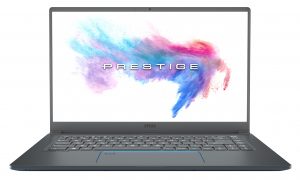
For every test like this, we use the same video in HD.




CPU options
Currently, this notebook comes with two families of choice – the Comet Lake-U processors, and the Ice Lake ones. You can choose from the Core i5-10210U or the Core i7-10510U from the former series, and the Core i5-1035G1 or the Core i7-1065G7 for the latter.
Results are from the Cinebench 20 CPU test (the higher the score, the better)
Results are from our Photoshop benchmark test (the lower the score, the better)
HP ENVY x360 15 (15-ed0000, ed1000) CPU variants
Here you can see an approximate comparison between the CPUs that can be found in the HP ENVY x360 15 (15-ed0000, ed1000) models on the market. This way you can decide for yourself which HP ENVY x360 15 (15-ed0000, ed1000) model is the best bang for your buck.
Note: The chart shows the cheapest different CPU configurations so you should check what the other specifications of these laptops are by clicking on the laptop’s name / CPU.
Results are from the Cinebench R23 CPU test (the higher the score, the better)
Results are from our Photoshop benchmark test (the lower the score, the better)
GPU options
Respectively, the graphics cards here are the integrated solutions – Intel UHG Graphics G1, and Iris Plus Graphics G7, as well as the dedicated GeForce MX330 with 25W of TGP and 4GB of GDDR5 memory.
Results are from the 3DMark: Time Spy (Graphics) benchmark (higher the score, the better)
Results are from the 3DMark: Fire Strike (Graphics) benchmark (higher the score, the better)
Results are from the Unigine Superposition benchmark (higher the score, the better)
HP ENVY x360 15 (15-ed0000, ed1000) GPU variants
Here you can see an approximate comparison between the GPUs that can be found in the HP ENVY x360 15 (15-ed0000, ed1000) models on the market. This way you can decide for yourself which HP ENVY x360 15 (15-ed0000, ed1000) model is the best bang for your buck.
Note: The chart shows the cheapest different GPU configurations so you should check what the other specifications of these laptops are by clicking on the laptop’s name / GPU.
Results are from the 3DMark: Time Spy (Graphics) benchmark (higher the score, the better)
Results are from the 3DMark: Fire Strike (Graphics) benchmark (higher the score, the better)
Results are from the 3DMark: Wild Life (Graphics) benchmark (higher the score, the better)
Results are from the Unigine Superposition benchmark (higher the score, the better)
Gaming tests

| Rise of the Tomb Raider (2016) | Full HD, Lowest (Check settings) | Full HD, Medium (Check settings) | Full HD, Very High (Check settings) |
|---|---|---|---|
| Average FPS | 38 fps | -fps | – |

| Shadow of the Tomb Raider (2018) | Full HD, Lowest (Check settings) | Full HD, Medium (Check settings) | Full HD, High (Check settings) |
|---|---|---|---|
| Average FPS | 29 fps | -fps | – |

| Tom Clancy’s Ghost Recon Wildlands | Full HD, Low | Full HD, Medium (Check settings) | Full HD, High (Check settings) |
|---|---|---|---|
| Average FPS | 30 fps | 21 fps | – |
Temperatures and comfort
Max CPU load
In this test we use 100% on the CPU cores, monitoring their frequencies and chip temperature. The first column shows a computer’s reaction to a short load (2-10 seconds), the second column simulates a serious task (between 15 and 30 seconds), and the third column is a good indicator of how good the laptop is for long loads such as video rendering.
Average core frequency (base frequency + X); CPU temp.
| Intel Core i7-10510U (15W TDP) | 0:02 – 0:10 sec | 0:15 – 0:30 sec | 10:00 – 15:00 min |
|---|---|---|---|
| HP Envy x360 15 (15-ed0000) | 3.24 GHz (B+80%) @ 71°C | 2.03 GHz (B+13%) @ 59°C | 2.07 GHz (B+15%) @ 62°C |
| HP Envy 13 (13-ba0000) | 3.30 GHz (B+83%) @ 83°C | 1.87 GHz (B+4%) @ 60°C | 1.72 GHz @ 65°C |
| Fujitsu LifeBook U7410 | 3.05 GHz (B+69%) @ 86°C | 2.65 GHz (B+47%) @ 96°C | 1.94 GHz (B+8%) @ 79°C |
| ASUS ZenBook Flip 14 UX463 | 3.50 GHz (B+94%) @ 92°C | 2.97 GHz (B+65%) @ 95°C | 2.31 GHz (B+28%) @ 73°C |
| Dell Inspiron 14 5490 | 3.62 GHz (B+101%) @ 80°C | 2.39 GHz (B+37%) @ 74°C | 1.92 GHz (B+7%) @ 65°C |
| Dell Inspiron 13 7391 2-in-1 | 3.50 GHz (B+94%) @ 98°C | 2.27 GHz (B+26%) @ 82°C | 2.09 GHz (B+16%) @ 79°C |
| Dell XPS 13 7390 | 3.62 GHz (B+101%) @ 89°C | 3.16 GHz (B+76%) @ 99°C | 2.70 GHz (B+50%) @ 85°C |
| Dell Vostro 5490 | 3.57 GHz (B+98%) @ 90°C | 2.51 GHz (B+39%) @ 87°C | 2.10 GHz (B+17%) @ 66°C |
This table definitely speaks for the conservative thermal management executed by HP. We see relatively low frequencies, but the chip is really cool at the end of the test.
Real-life gaming
| NVIDIA GeForce MX330 | GPU frequency/ Core temp (after 2 min) | GPU frequency/ Core temp (after 30 min) | GPU frequency/ Core temp (cooling pad) |
|---|---|---|---|
| HP Envy x360 15 (15-ed0000) | 1423 MHz @ 65°C | 1205 MHz @ 65°C | – |
| Lenovo Ideapad Flex 5 (14) | 1531 MHz @ 91°C | 1405 MHz @ 93°C | 1709 MHz @ 72°C |
Interestingly, Envy x360 15 (15-ed0000)’s MX330 works at very low clock speeds. Even compared to the Ideapad Flex 5 (14) and its terrible cooling solution. This is because, the frequency of the GPU, in this case, is adjusted to the temperature, with the junction point being 65C.
Comfort during full load
Even under combined load, such as gaming, the notebook remains relatively quiet, and the hottest part of the keyboard is the NumberPad section, at roughly 43C.
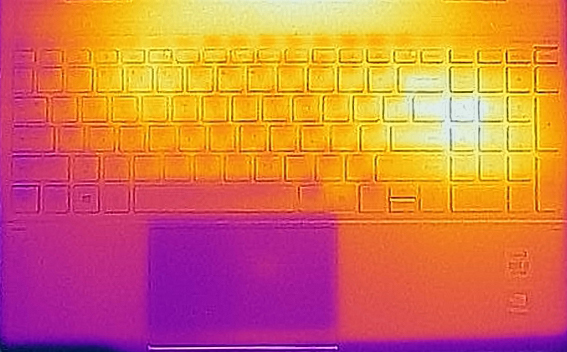

Verdict
You have great input devices, an optional Pen inside the box, and plenty of features to boost your artistic intentions. And on top of that, you can work on battery life, as it will last for pretty much an entire workday. Well, if we have to be precise, our unit got us through 8 hours and 20 minutes of light Web browsing and about 9 hours of video playback, but still. If you factor in your lunch break, and a couple of chats with co-workers, you should be able to get through the day without bringing a charger, right?
Let’s focus because the main event here is HP Envy x360 15 (15-ed0000)’s a touchscreen display. It has an IPS panel (Innolux N156HCG-GT1 (CMN1517)) with a Full HD resolution, comfortable viewing angles, good contrast ratio, and wide color coverage (97% of sRGB). Additionally, its backlight doesn’t flicker and it has a very accurate color representation when our Gaming and Web design profile is applied. This would make it great for design work and pretty much everyone working with color-sensitive content. However, the imperfect uniformity of our unit means it is inappropriate for the aforementioned situations.
Ultimately, this could be an isolated issue with our unit, but it can as much be something seen on every laptop of this model and screen panel. On the other side, there is the performance. Although the Core i7-10510U isn’t a powerhouse, and our benchmarks confirm that, we found out that the reason for the below-average performance of the chip is actually the actual way HP handles the thermals. Instead of going full house for maximum performance, the Envy x360 15 (15-ed0000) favors a low-noise/heat scenario, which leads to relatively low frequencies (still above the base), but a very cool notebook.
Sure, this gives a huge headroom to the GeForce MX330 to kick in with its 25W of TGP, and it definitely delivers. We were actually pretty impressed that you can play Tom Clancy’s Ghost Recon: Wildlands at 1080p low settings with 30 fps. This is a pretty big thing for a mobile chip of this caliber.
Additionally, you can configure the notebook with 32GB of dual-channel memory (although the manufacturer clearly states 16GB as a maximum). Also, having a fast M.2 PCIe x4 storage is always an advantage.
At the end of the day, when we put the pros and cons on the scale, we get a clear answer on whether you should get the Envy x360 15 (15-ed0000). And this answer is yes. With capital letters. The notebook is on point on almost every occasion, with the exception of the uniformity issue we found on this model. And if you are not the biggest fan of HP, or for some reason you didn’t like this device, you can check the ASUS ZenBook Flip 15 UX563, which sits on the opposite scale of the performance balance sheet.
Pros
- Two RAM SODIMM slots in dual-channel
- PCIe x4 support and aн SD card reader
- Has a great contrast ratio and a maximum brightness of 400 nits (Innolux N156HCG-GT1)
- Great for designers with 97% of sRGB coverage and accurate color representation (thanks to our Gaming and Web design profile) (Innolux N156HCG-GT1)
- Very fast fingerprint reader
- Amazing input devices
- Optional Pen inside the box
- Doesn’t use PWM to adjust its brightness level (Innolux N156HCG-GT1)
Cons
- Imperfect luminance uniformity denies artists of using this notebook for work
- Weird power button location
You can check the prices and configurations in our Specs System: https://laptopmedia.com/series/hp-envy-x360-15-15-ed0000/
